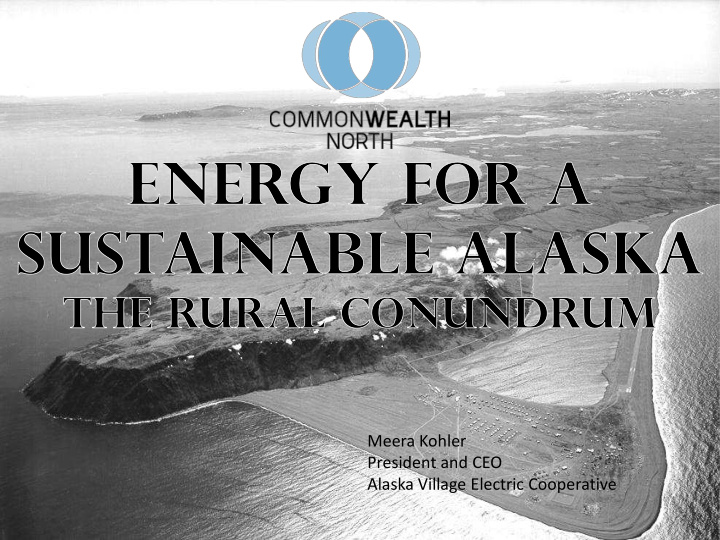



Meera Kohler President and CEO Alaska Village Electric Cooperative
Our Studies • Identify significant public policy issues that affect Alaska and its future • Educate Alaskans and others with deliberate, non- partisan findings and recommendations that enhance Alaskans’ quality of life and improve the State’s ability to effectively manage its resources
Rural & Alternative Energy Study Group The Charge Develop an understanding of the current state of energy production, transportation and consumption in rural Alaska and examine efforts underway to develop long-term, viable, cost- effective solutions to those challenges.
Rural & Alternative Energy Study Group The participants and contributors: Commonwealth North members Village and Native Corporation leaders Non-governmental public policy leaders Government agencies Energy industry and academic leaders Alaskans with varying degrees of knowledge of Alaska’s rural and alternative energy issues.
Members who participated in this study Co-Chairs Meera Kohler and Ethan Schutt, Julie Anderson, Ethan Berkowitz, Chris Birch, George Cannelos, Del Conrad, Denali Daniels, Mark Foster, Pat Galvin, Duane Heyman, Lonnie Jackson, Wilson Justin, Christine Klein, Mary Knopf, Kaye Laughlin, Marilyn Leland, Katie Marquette, Iris Matthews, Kate McKeown, Jason Meyer, Michael Moora, Christian Muntean, Karthik Murugesan, Kirk Payne, Mary Ann Pease, James Posey, Colleen Richards, Chris Rose, Debra Schnebel, Tiel Smith, Jan Van Den Top, Christine West, Dean Westlake, Michele White, and Tim Wiepking
Today, nearly 80% of rural communities are dependent on diesel fuel for their primary energy needs. How Alaskans Heat Their Buildings
Price per Gallon $3.00 $3.50 $4.00 $4.50 $5.00 $5.50 $6.00 $6.50 Nov-05 Jan-06 Average Alaska Fuel Prices Mar-06 May-06 Jul-06 Sep-06 Nov-06 Jan-07 Mar-07 May-07 Heating Fuel Jul-07 Sep-07 Nov-07 Jan-08 Survey Date Mar-08 May-08 Gasoline Jul-08 Sep-08 Nov-08 Jan-09 Mar-09 May-09 Jul-09 Sep-09 Nov-09 Jan-10 Mar-10 May-10 Jul-10 Sep-10 Nov-10 Jan-11
AVEC’s Delivered Fuel Cost • Average 2002 1.29 • Average 2003 1.47 +.18 • Average 2004 1.98 +.51 • Average 2005 2.26 +.28 • Average 2006 2.26 • Average 2007 2.93 +.67 • Average 2008 4.55 +1.62 • Average 2009 3.02 • Average 2010 3.30 • Average 2011 4.27 Increase 2002 - 2011 $2.98 +331%
The Cost of Energy Estimated Median Share of Income Alaska Households Spend for Home Energy Use
Rural residents use less than half as much total energy as people with natural gas or hydro power as in Anchorage and Southeast Alaska. 70 60 Barrels of Oil per Year 50 Wood & All Others Other Petroleum 40 Gasoline Diesel 30 Hydro Coal 20 Natural Gas 10 0 Alaska Gas Network PCE Areas Other
Power Cost Equalization Program (PCE) PCE was established in 1984 as a parity program to lower the end cost of electricity in rural Alaska while projects were built to lower costs in more urban areas PCE is a stop-gap measure to make a basic amount of electricity affordable for rural residents. Because PCE doesn’t reduce the cost of electricity for commercial users, high-cost energy continues to be a major impediment to economic development and financial sustainability of remote communities.
Fuel Distribution Routes to Rural Markets
OVERCOMING BARRIERS: Connecting Rural Alaska Strategically placed roads and transmission lines can play an important role in decreasing the capital, operations, and maintenance costs associated with energy development in rural Alaska.
Development of rural interties is an infrastructure investment which fosters efficiency and reduces redundancy. Interties not only improve access to reliable and affordable energy, but also to health care and educational opportunities.
Rural Alaska Regulatory and Permitting Roadmap
COMMONWEALTH NORTH Study Group Findings 1. Alaska needs a statewide energy vision, plan, and implementation strategy that incorporates a holistic view of statewide energy sustainability which serves all Alaskans similarly
COMMONWEALTH NORTH Study Group Findings 2. The interconnection of rural communities into regional electrical transmission grids develops economies of scale, creates efficiencies, reduces redundant infrastructure costs, and develops a greater potential for alternative energy projects
COMMONWEALTH NORTH Study Group Findings 3. In order to mitigate the high cost of energy in rural Alaska, dependency on diesel consumption must be reduced through increased efficiencies and utilization of economically viable alternatives
COMMONWEALTH NORTH Study Group Findings 4. A single statewide entity could coordinate energy generation and transmission project selection and advocate for all regions of the State in a balanced fashion
COMMONWEALTH NORTH Study Group Findings 5. Ensure high-value and effective investments in energy projects, and provide a “one stop shop” to deal with permitting and federal regulators
COMMONWEALTH NORTH Study Group Findings 6. Alaska should strive to eliminate the need for the Power Cost Equalization Program by reducing the electric rates paid by rural consumers to levels comparable to those paid by consumers on the Railbelt
What Alaskans Spend on Energy From 2010 Alaska Power Statistics: Electricity revenue $924 mm Gas revenue – Southcentral $536 mm Diesel – Fairbanks area 250 mm gallons Diesel – Kodiak, Copper Valley, SE 68 mm gallons Diesel – Rest of state 63 mm gallons TOTAL 381 mm gallons Diesel value at $4.00/gallon $1,524 mm Annual cost of electricity/heat $2,984 mm Expenditure in 20 years $59.7 billion
Recommend
More recommend